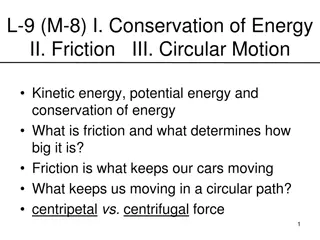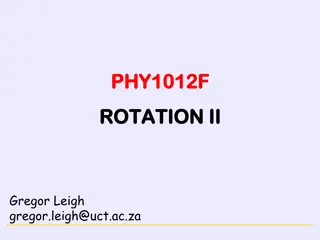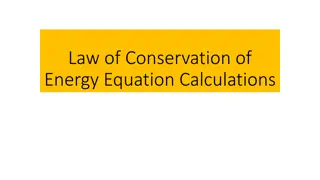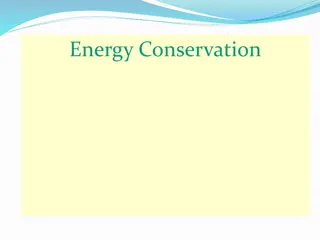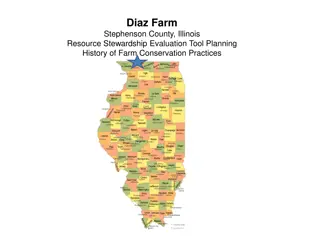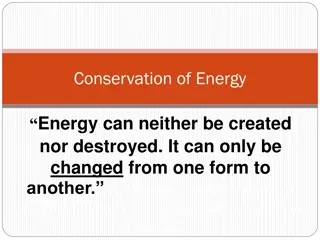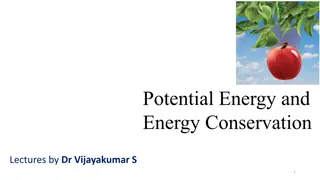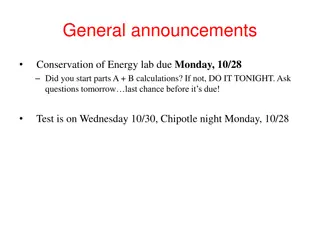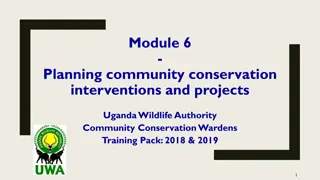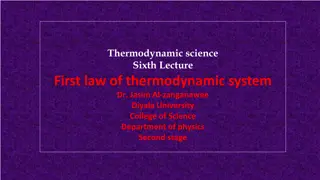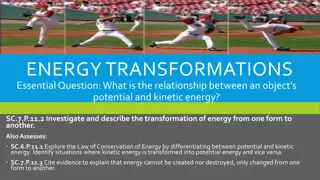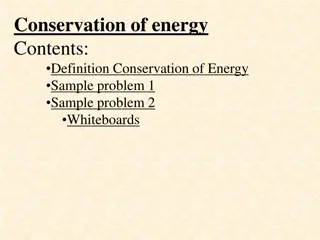Understanding the Law of Conservation of Energy
Scientists have studied energy and its transformations, leading to the law of conservation of energy. This law states that energy cannot be created or destroyed; it can only change forms. The concept is demonstrated through examples such as a diver's gravitational potential energy transforming into kinetic energy. Practice questions further reinforce the application of this fundamental law in scenarios like skiing and roller coasters.
Download Presentation

Please find below an Image/Link to download the presentation.
The content on the website is provided AS IS for your information and personal use only. It may not be sold, licensed, or shared on other websites without obtaining consent from the author. Download presentation by click this link. If you encounter any issues during the download, it is possible that the publisher has removed the file from their server.
E N D
Presentation Transcript
Conservation of Energy Pg. 184 - 191
Energy Transformations & The Law of. Scientists have studied energy and energy transformations and have arrived at some important generalizations For example, they noticed that when one form of energy is transformed into another form (or forms) of energy, the quantity of one form is reduced by the same amount that the quantity of the other form (or forms) is increased This generalization, known as the law of conservation of energy, is stated as follows: The Law of Conservation of Energy Energy is neither created nor destroyed. It can only change form.
Law of Conservation of Energy For example, consider a 65 kg diver who performs a handstand dive from a 10 m high diving platform into the water below:
Law of Conservation of Energy As you can see, while the diver s gravitational potential energy is transformed into kinetic energy throughout the dive, his total mechanical energy does not change it is conserved
note Law of Conservation of Energy Energy is neither created nor destroyed When energy changes from one form to another no energy is lost
Practice 1. A skier is gliding along with a speed of 2.0 m/s at the top of a ski hill 40 m high. The skier then begins to slide down the icy (frictionless) hill A) what will be the skier s speed at a height of 25 m? (17 m/s) B) at what height will the skier have a speed of 10 m/s? (35 m)
Practice 2. Many roller coasters have loops where carts roll on a track that curves sharply up into the air. In the roller coaster shown, the cart must have a minimum speed of 10 m/s at the top of the loop to make it around safely. Assuming that the roller coaster starts from rest at the top of the first hill and there is no friction on the roller coaster, what is the minimum height of the first hill? (21m)
System of Particles The law of conservation of energy is an example of a conservation law that applies to a system of particles that is completely isolated from outside influences an isolated system. Any group of objects can be defined as a system of particles
System of Particles Scientists classify systems according to their interaction with their surroundings An open system can exchange both matter and energy with its surroundings Matter does not energy or leave a closed system, but energy can enter or leave Neither matter nor energy can enter or leave an isolated system
System of Particles For example, an open pot of potatoes boiling on the stove represents an open system because heat is entering the pot and water vapour is leaving the system A pressure cooker prevents any matter from escaping by heat is entering, so the pressure cooker represents a closed system If the pot is placed inside a perfect insulator, neither heat nor water can enter or leave the system, making it an isolated system
System of Particles Take note: Physicists sometimes refer to an isolated system as a closed system to contrast it with an open system .. Textbook: Pg. 191 #2 5, 7






